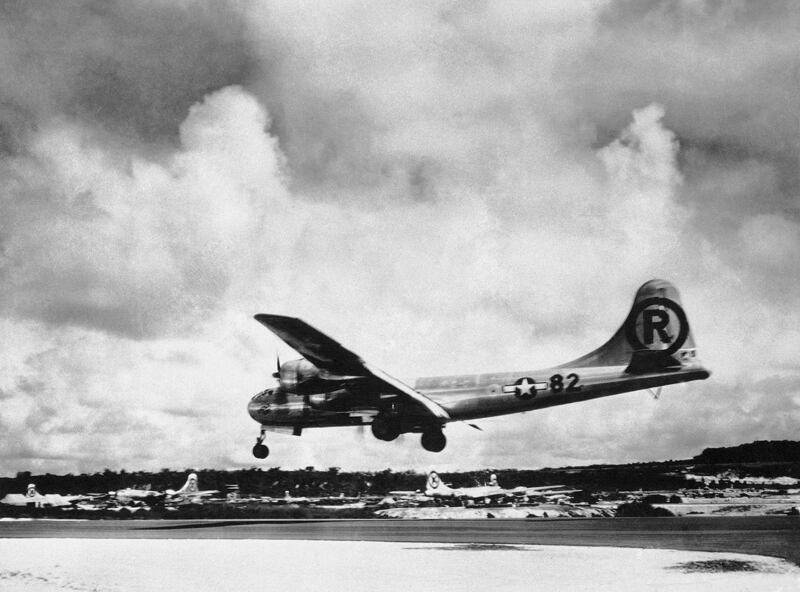“Now you’ve never met him,” comes the voice of Ralph Edwards, host of the wildly popular 1950s television show, “This Is Your Life.” You “have never seen him but he’s here tonight to clasp your hand in friendship.”
And with that, a large, square figure stepped out from behind a screen to shake the hand of what appears to be a deeply reticent Kiyoshi Tanimoto.
Tanimoto, a Methodist minister, was 36 years old when he became a survivor of Hiroshima. As to the shadowy figure who stepped out from behind the screen? Capt. Robert Lewis, co-pilot and aircraft commander of the Enola Gay — the B-29 bomber that unleashed the first atomic bomb, Little Boy, on the city of Hiroshima on Aug. 6, 1945.
At the time, Tanimoto was visiting the United States to coordinate care for 25 women who had been badly disfigured following the bomb on Hiroshima.
Dubbed the Hiroshima Maidens, the women were going to Mount Sinai Hospital in New York City for reconstructive surgery in May 1955, and Tanimoto believed he was in the studio to be interviewed about these women and their suffering, according to Electric Literature.
“This Is Your Life” — a show that often centered around surprising unsuspecting celebrities with the arrival of supportive friends and family — changed its tone with Tanimoto.
After asking Tanimoto to relive the morning of the bombing, the show begins to play an air raid siren, flashing between Tanimoto’s startled face and newsreel clips of the attack.
“The time has come, that split second of eternity which comes in one way or another to every man in his lifetime,” Edwards says to Tanimoto. “What did you do when you heard that bomb?”
“Well, I didn’t hear any sounds, but I saw strange flash running through the air,” replied the minister.
Throughout much of the rest of the interview, Tanimoto says very little, with Edwards guiding his guest into each new topic ranging from greeting the minister’s former U.S. church congregation to cringe-worthy questions such as “where were you on December 7, 1941?”
“It’s not only that Edwards mostly refuses to let his subject speak,” the Electric Literature report states. “It’s that he continually takes the liberty of describing Tanimoto’s feelings and memories to Tanimoto, often speaking over him to do so… He embodies an America that will bomb your home, kill your neighbors, surprise you with an interview on a deeply personal, traumatic experience and then — rather than allow you to tell your own story — tell you what happened and how you felt about it.”
Around the 16-minute mark of the show, Lewis makes his appearance.
“Captain Lewis, come in here close,” Edwards beseeches the airman.
Lewis and Tanimoto remain awkwardly as far apart on screen as possible.
A visibly nervous Lewis begins to haltingly give an account of his experience on the morning of Aug. 6, 1945, to a stone-faced Tanimoto before relaying, head in hand, that he wrote in his logbook after the infamous flight, “My God, what have we done?”
In a This American Life story about “This is Your Life,” Allison Silverman reports that “Lewis is the one you’re most worried about watching this bizarre blind date. Ralph Edwards is pleased. Tanimoto is respectful, but Captain Lewis looks like he’s breaking down. People say he went to a bar before the show and came back drunk.”
The men shake hands once again and Lewis swiftly leaves stage left.
The bizarre interaction caused many, including Jack Gould at The New York Times, to accuse the show of exploiting the raw and private emotions of victims. Time magazine called Ralph Edwards a “spiritual prosecutor” to his guests.
Lewis, it appears, remained haunted by his actions.
During the show, Lewis pledged a contribution to Tanimoto’s Hiroshima Maiden’s fund “on behalf of the entire crew that participated in that mission, my company, and my lovely family.”
Lewis’ crewman, Paul Tibbets, insisted until he died in 2007 that he had no regrets about dropping the bomb.
In 1971, Lewis sold his famous log where he declared, “Just how many Japs did we kill? … My God, what have we done?” and used the money from the sale to buy marble for his new hobby: sculpture.
His piece — a mushroom cloud with streams of blood flowing down the side — was later given to Dr. Glenn Van Warrebey, an American psychiatrist who treated Lewis, seemingly for post-traumatic stress disorder.
Tanimoto’s daughter Koko Kondo later recalled to Silverman that her father had fond memories of his appearance on the show despite the ambush on live TV.
“He wasn’t horrified by meeting Captain Lewis, the co-pilot of the Enola Gay. In fact, the two of them started writing each other after the show,” Kondo told Silverman. “Captain Lewis changed her whole attitude about the old enemy. Seeing him tear up on stage at the El Capitan, she stopped hating American soldiers.”
This story originally appeared on HistoryNet.com.
Claire Barrett is the Strategic Operations Editor for Sightline Media and a World War II researcher with an unparalleled affinity for Sir Winston Churchill and Michigan football.




